2012 600 Trail Sports Class Roundup
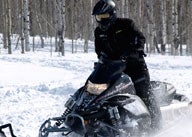
Today's 600 category includes the one-liter four-stroke option
It used to be known simply as the “600” class because that was the engine size used in that popular category of trail sport sleds. It’s not quite that simple any longer. Today’s version of the 600 class includes two sleds with traditional sized 600cc two-stroke power and two others with four-stroke equivalents that measure more than 1000cc. While the power packages have changed, the 600 concept remains relatively intact.
What made the 600 category popular centered on power, weight, packaging and price. While not the least expensive sleds available, the 600 models provided excellent value. Within the samplings of the various models you’d find performance-oriented suspension packages designed to handle rough terrain and tight corners. The brakes would be derived from racing applications and the seating position would usually reference snocross experience. Back when virtually all performance sleds utilized two-stroke power, you could figure that each manufacturer’s 600cc twin would pump out something in the vicinity of 120 horsepower.
Move to 2012 and some things have changed. The idea of value-packing a trail hot rod with top performance features hasn’t really changed. But how the new breed of 600 class sleds gets there has changed quite a bit.
The Power
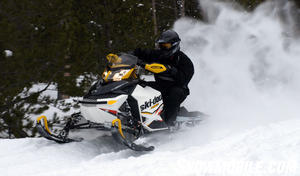 Ski-Doo’s E-TEC engine technology was developed from Evinrude outboard concepts.
Ski-Doo’s E-TEC engine technology was developed from Evinrude outboard concepts.
Today we see some interesting ways of getting power from the injector to the track. Ski-Doo provides the most sophisticated development, as it believes that two-stroke engines offer distinct advantages over four-stroke engine designs. Two-strokes tend to be light in weight as they are devoid of overhead cams, complicated valve trains and such. However, while Ski-Doo and its engine builder, Rotax, may not deal with the internal complications of a four-stroke, the development of its direct injection E-TEC system requires an incredible coordination of fuel to ignition spark. Literally, timing is everything as the E-TEC engine relies on a powerful blend of computerization that combines with precision placement of the incoming and exiting fuel pulses. The E-TEC design features an engine control module that manages up to 8,000 calculations per second and generates enough heat that Rotax engineers had to cool it with fuel.
While new to snowmobiling, direct injection has been a hallmark feature with sister company Evinrude and it was a combined effort between Evinrude and Ski-Doo engineers that led to the E-TEC. This engine design allows the Ski-Doo twin to claim almost four-stroke-like emissions and fuel efficiency.
Although Yamaha’s Nytro three-cylinder four-stroke delivers nearly 10 percent more power than the 600 E-TEC, the Ski-Doo’s nearly 100 pound lighter weight gives it a power-to-weight advantage, negating the Yamaha’s higher horsepower.
Both Yamaha and Arctic Cat offer four-strokes in this new breed of 600 sleds. The Yamaha triple measures 1049cc with the Suzuki-built Arctic Cat twin displacing 1056cc. The other traditional 600 two-stroke motor comes in Polaris’ Rush and displaces 599cc. All the engines are fuel injected with the Polaris Cleanfire featuring a semi-direct induction, similar to Ski-Doo’s SDI twin, which is now replaced by the E-TEC.
Since the Polaris Rush weighs more than the Ski-Doo TNT, but has similar claimed horsepower, the power-to-weight advantage again goes to the Ski-Doo.
On the trail you’ll fid that performance will be similar, with the two-stroke models giving you a heightened sense of explosive acceleration. In our opinion, Arctic Cat’s one-liter twin works better in the new Procross chassis than it does in the Twin Spar models. It’s not the quick revving engine that Yamaha’s Nytro or the two-strokes are, but it performs well.
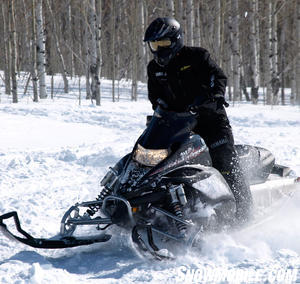 Yamaha’s Nytro combines the smoothness of a four-stroke triple with high performance suspensions.
Yamaha’s Nytro combines the smoothness of a four-stroke triple with high performance suspensions.
The Yamaha Nytro is clutched for a quick hit on the throttle that sets you back on the saddle, as it wants to lift the skis on acceleration. That spells performance for some riders. We would much prefer the calmer action Yamaha built into its Vector series, but we appreciate that Yamaha needs to differentiate between the two power packages and wants to give its sport ridership a bigger thrill.
While the idea of the E-TEC is impressive, on the trail and at the throttle, we can’t find a big difference between the Polaris Cleanfire and Ski-Doo E-TEC drive systems. Both are very sporty and give these traditional 600 class sleds the edge in the power department.
The Underpinnings
We realize that Ski-Doo has challenged Arctic Cat in court and we understand why. It’ll be easier for you to get the reason when you test ride the pair head-to-head. The new Procross chassis used in the Arctic Cat F1100 gives the latest sport Cat an incredibly nimble feel. While we think the existing powerplant seems a bit lazy when compared to the other engines in this category, there is no disputing that Arctic Cat engineers hit the sweet spot for trail riding. The tall-spindled front end works well. It turns in early and easily when cornering. The proven and retuned FasTrack Slide-Action rear suspension complements the front set up very well.
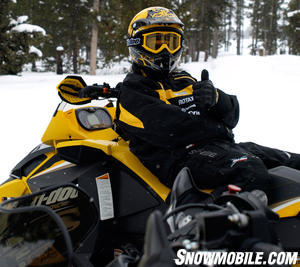 The ever popular 600 class gets a big thumbs up from trail sport riders.
The ever popular 600 class gets a big thumbs up from trail sport riders.
What makes the Ski-Doo MXZ TNT our overall favorite centers on its incredibly light feel. At a claimed 425-pounds, the TNT responds to driver input better than all of the other sleds in this class. Keep in mind; we are speaking in an overall sense. Moving from one side to the other or pushing weight into the runningboard has a direct and nearly instant effect on this sled’s momentum. This all goes back to the sled’s light weight makeup and the overall riding position, which Ski-Doo seems to have nailed with the REV-XP chassis. Therein lies the problem as Ski-Doo feels that Arctic Cat’s Procross design too closely resembles the REV.
To us, the fact is that the Arctic Cat actually steers better than the MXZ, and while it may resemble the rider-forward REV, it simply doesn’t respond as quickly to rider movements, relying more on actual front end grip than the rider kicking the sled around.
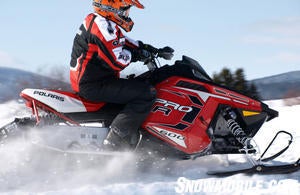 Using a front suspension refined by its racing department makes the Polaris Rush Pro-R a top choice.
Using a front suspension refined by its racing department makes the Polaris Rush Pro-R a top choice.
We found the 2012 Polaris 600 Rush Pro-R finally getting closer to the Ski-Doo MXZ TNT 600. For us the front end and rear suspension upgrades to the 2012 Rush brought the Polaris a giant step forward. By changing over to a front end that more closely replicates the design used by Polaris’ racers, the Rush gains big improvements in steering. The change helps keep the skis from popping up when you charge hard into a turn. The sled’s overall balance is now calm and positive. It took Polaris three seasons, but the front end works extremely well. Much more like the Ski-Doo MXZ!
Yamaha calls its Nytro RTX a trail-calibrated racer replica. It is a strong runner, but it can wear you down during a 100 miles of ditch banging. That engine/clutch complaint we made earlier actually works for this sled when entering rough territory. If you want to get front-end lift, this sled is designed for it. Hit the throttle hard, slide back a titch and work over a series of moguls. It’s an easy sled to ride standing upright and its front and rear suspensions come with performance shock packages expressly suited for big bump banging. The triple cylinder engine has been specifically tuned to hit the clutches aggressively, which may not be our style, but it does satisfy aggressive Yamaha riders very well. The Nytro’s1049cc engine’s tuning is designed for controlled spikes as opposed to the milder cam settings favored by Vector buyers. The end result is a sled that allows you to tackle cross-country travel.
Of the four 600 class sleds that will be available at dealerships this time of year, the Ski-Doo MXZ TNT slips a bit in the ratings because it will come with the tried and true SC-5 rear suspension instead of the new rMotion, which was only available by special pre-season order. We expect that you’ll find a wider application of the rMotion design on 2013 models, but for right now, if you didn’t order early, the SC-5 will be the suspension of choice. It works fine, but the updated Polaris Pro-Ride with Walker Evans shock package is better. That’s the point; Ski-Doo’s rMotion comes as a direct result of the Pro-Ride.
In Our Opinion
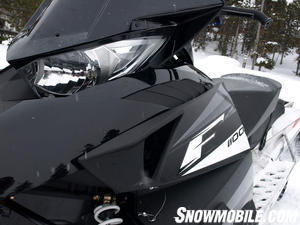 Arctic Cat’s 2012 F1100 brings styling flair to the new breed of 600 class sleds.
Arctic Cat’s 2012 F1100 brings styling flair to the new breed of 600 class sleds.
You have four choices right now. Your choices were better last April when the sled makers were offering special deals, but they aren’t bad right now. From a performance view we figure that the new 600 class outshines its predecessors. The 2012 models offer incredible choice. The traditionalist will find the latest 600cc two-stroke powered models retaining the old values while adding improvements in under hood performance thanks to ongoing engineering that gives us both direct and semi-direct injected two-strokes. The result is that the latest 600cc two-strokes respond more positively and are more economical and efficient. The fact that the two-stroke powered models are also lighter in weight translates well to the trail where nimble handling is a proven asset.
The four-stroke models will give you low-end torque and a sense of strong pull from corner to corner. While there can be a weight penalty with these four-stroke sleds, the four-strokes like the Yamaha Nytro offer a power advantage. Of course, when you factor in power to weight, you’ll discover that these four sleds will be close and there is virtually no huge advantage.
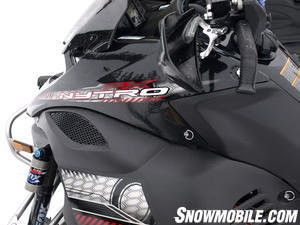 Sport-styled handlebars and premium grade shocks highlight the 600 category of trail sport sleds.
Sport-styled handlebars and premium grade shocks highlight the 600 category of trail sport sleds.
Frankly, any of the 600 class sleds would satisfy us. There is the prejudice for or against two-strokes — or, four-strokes for that matter. There is the matter of overall sled weight and how you feel about that.
From a feature and design standpoint, the 2012 series of 600 class sleds remains true to the tradition of sport handling for the trail. Each of the sleds in the class will provide you with a premium suspension that is outfitted with high grade gas charged shocks to control upwards of 10 inches of front travel and nearly 15 inches of rear suspension to soak up deep moguls. These sleds give you a riding position designed to let you kick back for speedy travel on groomed trails or stand-up for grabbing big air. All of these sleds let you fly straight and true over big bumps. They will turn easily into and grip a corner. And they will come with the latest modern gadgets like digital displays, sport handlebars with racer-inspired ends, performance hydraulic disc brakes and aggressive snow ripping tracks.
Related Reading
2012 Ski-Doo MXZ TNT 600 E-TEC Review
2012 Arctic Cat F1100 Sno Pro Review
2012 Polaris 600 Rush Review
2012 Yamaha FX Nytro RTX Review



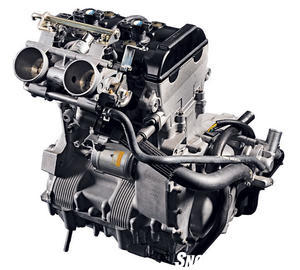
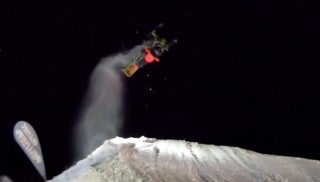
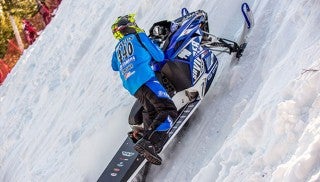
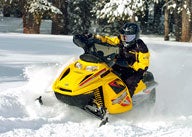


 Your Privacy Choices
Your Privacy Choices